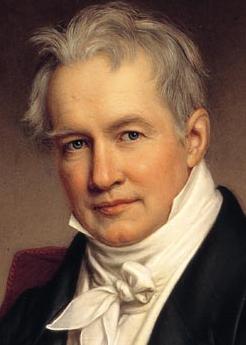Humboldt, Friedrich Heinrich Alexander, Baron von (1769–1859)

Friedrich Humboldt was a German naturalist. With the botanist Aimé Jacques Alexandre Bonpland (1773–1858) he traveled for five years through much of South America (1799–1804), collecting plant, animal, and rock specimens and making geomagnetic and meteorologic observations. Humboldt published their data in 30 volumes over the next 23 years. In his most important work, Kosmos (1845–62), he sought to show a fundamental unity of all natural phenomena.
Early life
Humboldt, son of the chamberlain of the king of Prussia, was born in Berlin. Destined for a political career he studied at the University of Frankfurt an der Oder. But an even at an early age Humboldt showed that his real interest lay in the wide realms of nature and subsequently he studied geology at Freiburg, anatomy at Jena, and even astronomy. His first publication, a treatise on the basaltic rocks of the Rhine, appeared in 1790. This was followed by a publication on the flora of the mines at Freiburg (1793), a work on the irritability of the muscular and nervous fibers of animals (1799) and various papers on mineralogy.
In 1796 he resigned from his official post of assessor of mines in order to devote more time to the study of nature and three years later set out on an expedition of scientific exploration to South America. During the course of the next fire years he not only explored a vast area of South America but also laid the basis of physical geography and meteorology in a wide sense as accurate sciences. He was the first to study the rate at which temperature decreases with height, an investigation which involved the ascent of Chimborazo and other high Andean mountains. He also considered the origin of tropical storms and discovered that the intensity of the Earth's magnetism decreases toward the equator (though there were rival claims to this distinction). His work on the geographical distribution of plants and animals as affected by physical conditions was the first in this field. One of his most important achievements was the mapping of the Earth's surface with lines joining points of equal average temperature (isotherms), thus providing for the first time a means of comparing the climatic conditions of different regions. His services to cartography were also considerable. Many errors and blanks in the map of South America were filled in by his explorations and he determined hundreds of terrestrial positions by means of astronomy.
In 1829 Humboldt embarked on another expedition, this time to the north of Asia under the patronage of the Russian government. The main achievements of this expedition were the examination of the beds which produce gold and platinum and the discovery of diamonds. Other work included the collecting of botanical specimens and magnetic observations (terrestrial magnetism being one of Humboldt's chief fields of inquiry).
Science and state
Humboldt's scientific investigations were often hampered by his service to the state. He held a high position at the Prussian court and after 1830 was frequently entrusted with diplomatic missions to the court of Louis Philippe of France. Yet his position was of value to science for Humboldt stressed the need for cooperation among nations in the field of science. An initial success in this direction was the establishment of a chain of magnetic and meteorological stations across Russia.
Between 1845 and 1847 appeared the first two volumes of Humboldt's last and greatest work. This was Kosmos, a work in which Humboldt intended to set out and describe the whole of the physical world. It was the culmination of an idea which had been born over half a century before and the fulfillment of which had been repeatedly delayed. The third and fourth volumes of this work were published in 1850 and 1858, while part of a fifth appeared posthumously.
Humboldt's legacy
It is difficult to estimate the true value of Humboldt's contribution to science, partly because no single great discovery can be credited to him and partly because his investigations ranged over such a wide field. For instance, he even found time to work with Gay-Lussac in conducting experiments on the chemical composition of the atmosphere. But there is no doubt that the interest aroused in Europe as a result of Humboldt's varied work greatly helped the cause of scientific exploration. It is a fitting tribute that several towns, a river, a range of mountains, a glacier, and even an ocean current bear his name.


